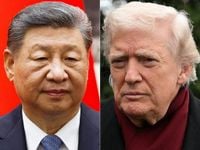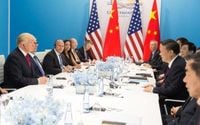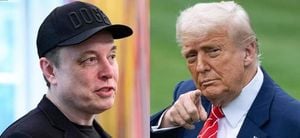On November 24, 2025, U.S. President Donald Trump and Chinese President Xi Jinping held a pivotal phone call that signaled a new chapter in the often turbulent relationship between the world’s two largest economies. The conversation, which followed their in-person meeting in Busan, South Korea, just weeks prior, covered a broad spectrum of pressing global and bilateral issues, including trade, the ongoing war in Ukraine, fentanyl trafficking, and the contentious question of Taiwan.
President Trump, in his characteristic style, took to Truth Social shortly after the call to declare, “I just had a very good telephone call with President Xi, of China. We discussed many topics including Ukraine/Russia, Fentanyl, Soybeans and other Farm Products, etc. We have done a good, and very important, deal for our Great Farmers — and it will only get better. Our relationship with China is extremely strong!” According to Reuters and IBNS, Trump emphasized that the call was a follow-up to their “highly successful meeting in South Korea, three weeks ago,” and noted “significant progress on both sides in keeping our agreements current and accurate.”
The most immediate outcome of the call was Trump’s acceptance of Xi’s invitation to visit Beijing in April 2026. In turn, Trump invited Xi for a State Visit to the United States later that year, a gesture that both sides framed as a sign of deepening trust and cooperation. This would mark Trump’s first visit to Beijing since November 2017, when he traveled to China during his first term, and comes after he hosted Xi at his Mar-a-Lago resort in Florida that same year.
Trade was front and center in the leaders’ discussion. The relationship between the U.S. and China has been strained for years by tit-for-tat tariffs and disputes over market access, intellectual property, and supply chains. However, after months of escalating tensions triggered by Trump’s tariff announcements, the October 30 meeting in Busan resulted in a framework agreement that appears to have steadied the ship—at least for now. Under the terms of that deal, the U.S. agreed not to impose 100% tariffs on Chinese imports, and instead lowered tariffs by 10%, reducing the average duty from 57.6% to 47.6%. In exchange, Beijing pledged to suspend its expanded export restrictions on rare earths and critical minerals for one year, resume purchases of U.S. soybeans, and crack down on fentanyl smuggling—a synthetic opioid fueling a deadly crisis in North America.
White House press secretary Karoline Leavitt told reporters that the primary focus of the call was trade, rather than pressuring Xi on the Russia-Ukraine conflict. “Russia-Ukraine did come up, but the focus was mainly on the trade deal that we are working on with China,” Leavitt said, according to Reuters. She described the call as lasting about an hour and said, “We are pleased with what we’ve seen from the Chinese, and they feel the same way.”
On the Chinese side, Xi Jinping expressed optimism about the trajectory of U.S.-China relations. “The facts again show that cooperation benefits both sides while confrontation hurts both,” Xi told Trump, as reported by China’s official Xinhua news agency and cited in Reuters. He called for the two countries to “maintain positive momentum” and reiterated China’s support for “all efforts conducive to peace in Ukraine.”
But beneath the surface of economic cooperation, geopolitical tensions simmered—most notably over Taiwan. While Trump made no mention of Taiwan in his public statements about the call, the Chinese Foreign Ministry was explicit. According to its readout, Xi told Trump that “Taiwan’s return to China is an integral part of the post-war international order” forged in the joint U.S.-China fight against “fascism and militarism.” China regards the self-governing island as part of its territory and has not ruled out the use of force to achieve reunification. The U.S., while not officially recognizing Taiwan’s claim to statehood, remains the island’s most important partner and arms supplier, a balancing act that has long frustrated Beijing.
This diplomatic maneuvering comes at a time when China is locked in a heated standoff with Japan over Taiwan’s future. Japanese Prime Minister Sanae Takaichi recently declared that Japan’s military could intervene in any Chinese attack on Taiwan, a stance that drew Beijing’s ire. Earlier on the day of the Trump-Xi call, China criticized Tokyo’s plans to deploy a medium-range surface-to-air missile unit on Yonaguni, an island just 110 kilometers off Taiwan. “China’s deeper fear is about the potential of future Japanese militarization,” Marvin Park, a former director for Taiwan on the U.S. National Security Council, told Reuters. “If they bring in this purely defensive system now, that could make it easier on the Japanese side to advocate for more advanced capabilities in the southwest islands.”
Despite these flashpoints, both leaders appeared keen to project stability and progress. Trump’s statement that “frequent communication between the two leaders would be important going forward” was echoed in Xi’s call for regular dialogue. As Al Jazeera reported, Trump said, “Now we can set our sights on the big picture… We agreed that it is important that we communicate often, which I look forward to doing.”
Another critical issue on the agenda was the opioid crisis. China’s agreement to crack down on the smuggling of fentanyl precursors—a key component in the synthetic opioid epidemic devastating American communities—was a significant concession. The U.S. has long accused China of being the primary source of chemicals used to manufacture fentanyl, and the new pledge was welcomed in Washington as a step toward addressing the crisis.
The agricultural sector also stood to benefit from the renewed cooperation. After months of being shut out of the Chinese market, American soybean farmers saw a glimmer of hope as Beijing agreed to resume purchases. Trump, never one to miss an opportunity to tout a deal, wrote, “We have done a good, and very important, deal for our Great Farmers – and it will only get better.” According to IBNS, this was part of a broader effort to ensure that “the relationship with China is extremely strong.”
While the framework agreement and the cordial tone of the leaders’ statements suggest a thaw in U.S.-China relations, the path ahead remains fraught with uncertainties. The final details of the rare earths deal, for instance, have yet to be hammered out. U.S. Treasury Secretary Scott Bessent expressed hope that an agreement would be reached by Thanksgiving, but as with all things in international diplomacy, nothing is certain until the ink is dry.
For now, both sides are eager to highlight progress and keep the momentum going. As Xi put it, “cooperation benefits both sides while confrontation hurts both.” Whether this spirit of collaboration will withstand the next crisis—be it over Taiwan, trade, or global security—remains to be seen. But for a moment, at least, Washington and Beijing are talking, and that’s no small feat in today’s world.





